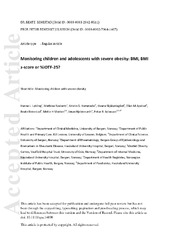| dc.contributor.author | Løkling, Hanne L | en_US |
| dc.contributor.author | Roelants, Mathieu | en_US |
| dc.contributor.author | Kommedal, Kristin | en_US |
| dc.contributor.author | Skjåkødegård, Hanna Flækøy | en_US |
| dc.contributor.author | Apalset, Ellen M | en_US |
| dc.contributor.author | Benestad, Beate | en_US |
| dc.contributor.author | Morken, Mette Helvik | en_US |
| dc.contributor.author | Hjelmesæth, Jøran | en_US |
| dc.contributor.author | Juliusson, Petur Benedikt | en_US |
| dc.date.accessioned | 2019-08-22T11:19:26Z | |
| dc.date.available | 2019-08-22T11:19:26Z | |
| dc.date.issued | 2019 | |
| dc.Published | Løkling, Roelants M, Kommedal K, Skjåkødegård HF, Apalset EM, Benestad B, Morken MH, Hjelmesæth J, Juliusson P. Monitoring children and adolescents with severe obesity: body mass index (BMI), BMI z‐score or percentage above the International Obesity Task Force overweight cut‐off? Acta Paediatrica. 2019 | eng |
| dc.identifier.issn | 0803-5253 | |
| dc.identifier.issn | 1651-2227 | |
| dc.identifier.uri | https://hdl.handle.net/1956/20700 | |
| dc.description.abstract | Aim: Body mass index (BMI) metrics are widely used as a proxy for adiposity in children with severe obesity. The BMI expressed as the percentage of a cut‐off percentile for overweight or obesity has been proposed as a better alternative than BMI z‐scores when monitoring children and adolescents with severe obesity. Methods: Annual changes in BMI, BMI z‐score and the percentage above the International Obesity Task Force overweight cut‐off (%IOTF‐25) were compared with dual‐energy X‐ray absorptiometry (DXA) derived body fat (%BF‐DXA) in 59 children and adolescents with severe obesity. Results: The change in %BF‐DXA was correlated with the change in %IOTF‐25 (r = 0.68) and BMI (r = 0.70), and somewhat less with the BMI z‐score (r = 0.57). Cohen's Kappa statistic to detect an increase or decrease in %BF‐DXA was fair for %IOTF‐25 (κ = 0.25; p = 0.04) and BMI (κ = 0.33; p = 0.01), but not for the BMI z‐score (κ = 0.08; p = 0.5). The change in BMI was positively biased due to a natural increase with age. Conclusion: Changes in the BMI metrics included in the study are associated differently with changes in %BF‐DXA. The BMI z‐score is widely used to monitor changes in adiposity in children and adolescents with severe obesity, but the %IOTF‐25 might be a better alternative. | en_US |
| dc.language.iso | eng | eng |
| dc.publisher | Wiley | eng |
| dc.subject | Body mass index | eng |
| dc.subject | Childhood obesity | eng |
| dc.subject | Monitoring | eng |
| dc.title | Monitoring children and adolescents with severe obesity: body mass index (BMI), BMI z‐score or percentage above the International Obesity Task Force overweight cut‐off? | en_US |
| dc.type | Peer reviewed | |
| dc.type | Journal article | |
| dc.date.updated | 2019-06-25T13:26:19Z | |
| dc.description.version | acceptedVersion | en_US |
| dc.rights.holder | Copyright 2019 Foundation Acta Pædiatrica | |
| dc.identifier.doi | https://doi.org/10.1111/apa.14898 | |
| dc.identifier.cristin | 1705361 | |
| dc.source.journal | Acta Paediatrica | |
| dc.source.pagenumber | 2261-2266 | |
| dc.source.volume | 108 | |
| dc.source.issue | 12 | |
